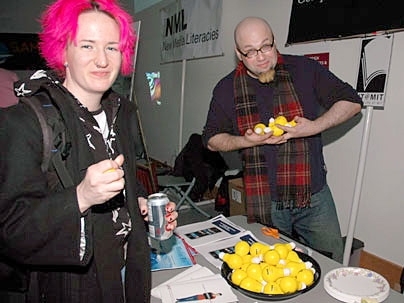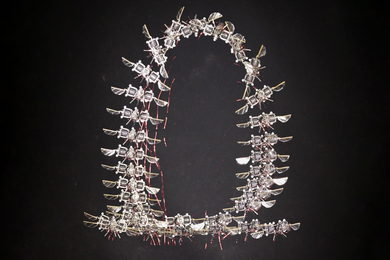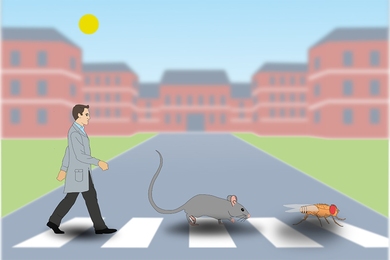The students, staff and faculty of MIT's Comparative Media Studies program showed they could walk the walk and talk the talk of transformative media technology when they turned the Stata Center lobby into an attention-grabbing interior landscape on Feb. 22.
A human-sized comic book hero placard pointed the way. A three-section slide show filled a wall with moving images of CMS projects. Computers, brochures and, of course, food competed for table space. "Grab a stress bulb," CMS undergraduate administrator Generoso Fierro told passersby as he handed out squeezable canary-colored toy light bulbs, stamped with "Comparative Media Studies."
Most important, on hand to chat and answer questions were representatives of the Convergence Culture Consortium, New Media Literacies, the Educational Arcade, Hyper Studio and other programs within CMS, itself part of MIT's literature section.
The occasion was the CMS Colloquium special event: "Converging Media: Games, Literacy and Culture Research Fair."
"We wanted to show the range of activities CMS is involved in," explained DeFlorez Professor of Humanities Henry Jenkins. "It's also a chance to show our students about branding and publicity. We always get kids to think about our messages and our role as communicators."
Of great satisfaction to Geoffrey Long, a second-year graduate student, was the timing of the three PowerPoint projectors that were showing images of CMS projects in a continuous loop. Each projector managed, every 30 seconds, to coordinate the projection of the words "Comparative Media Studies" across the wall.
He hoped that students walking into the fair would get a sense of excitement.
"The greatest thing about CMS is that it's still a small department but it's the fastest growing undergraduate major,'' Long said. "There's so much cool stuff happening here. The concept of the fair is to spread that out a little bit. I don't think people know about us as much as they should."
One of the newer projects is a joint MIT and Singapore project, the "Gambit Game Lab," which will promote and foster digital game research globally. Philip Tan, Gambit executive director, chatted with fair-goers under a Gambit banner and near a laptop loaded with some of his personal game collection.
"We're focusing on innovation in a way that makes it practical," he explained, as a zombie stumbled with a menacing gait across the laptop's screen. That requires "trying to take every single one of our research ideas and build a game out of it. Not only does that mean we have to keep ourselves very practical but gives a means of sending our research out."
Projects include the development of new games played with body movement or that use aural cues; this may open up the game market to the sight impaired, Tan said. Such innovations may require new genres or stories. For example, previously unserved gamers may not like zombies, Tan noted, although he added with a grin, "a lot of people do like zombies."
"It's very important for us in CMS to observe the medium as it develops and maybe even try to contribute to it so it can run the gamut of all the different kinds of expressions it's capable of," Tan said. "None of us want to see games pigeonholed. There's a tendency for the gaming industry to do that because risk is such an issue."
Across the lobby, Scot Osterweil, creative director of the Education Arcade--which explores the use of educational games--fielded numerous questions about an education game in development, tentatively called "Labyrinth." Designed to teach math and literacy to middle school students, Labyrinth features puzzles and monsters that challenge students to solve problems; it's not meant for play during school hours but kids may play it at home to prepare themselves for a math curriculum in class.
"This is a chance to restate what good learning games are about," Osterweil explained. Behind him a poster proclaimed the four "freedoms" of game play: freedom to fail, freedom to experience, freedom of effort and freedom to try on new identities.
The fair demonstrated that CMS research "may be serious but it's also fun and has real-world applications," said Margaret Weigel, New Media Literacies research manager.
A version of this article appeared in MIT Tech Talk on February 28, 2007 (download PDF).







